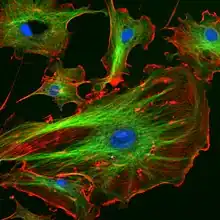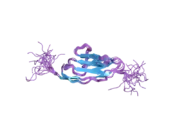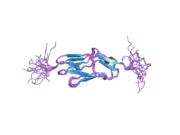Palladin
Palladin is a protein that in humans is encoded by the PALLD gene.[5][6][7][8] Palladin is a component of actin-containing microfilaments that control cell shape, adhesion, and contraction.[8]
Discovery
Palladin was characterised independently by two research groups, first in the lab of Carol Otey (in 2000)[6] and then in the lab of Olli Carpén (in 2001).[9] It is a part of the myotilin-myopalladin-palladin family and may play an important role in modulating the actin cytoskeleton.[10] Palladin, in contrast to myotilin and myopalladin, which are expressed only in striated muscle, is expressed ubiquitously in cells of mesenchymal origin.
Palladin was named after the Italian Renaissance architect Andrea Palladio, reflecting its localization to architectural elements of the cell.[6]
 The eukaryotic cytoskeleton. Palladin is one component of this complex cellular machinery. |
Isoforms
In humans, it appears that seven different isoforms exist, some of which arise through alternative splicing.[11] In mice, three major isoforms of palladin arise from a single gene. These isoforms contain between three and five copies (depending on the isoform) of an Ig-like domain and between one and two copies of a polyproline domain.[6]
Function
Palladin's precise biological role is poorly understood, but it has been shown to play a role in cytoskeletal organization, embryonic development, cell motility, scar formation in the skin, and nerve cell development.[10]
Disease linkage
Recently, it has been demonstrated that palladin RNA is overexpressed in patients with pancreatic neoplasia, and that palladin is both overexpressed and mutated in an inherited form of pancreatic cancer.[12] The palladin mutation identified in familial pancreatic cancer may be unique to a single North American family, as this same mutation has not been found in any other European or North American populations, respectively, in two other genetic studies.[13][14]
Further, Salaria et al. have shown that palladin is overexpressed in the non-neoplastic stroma of pancreatic cancer, but only rarely in the cancer cells per se,[15] suggesting that palladin's role in this disease may involve changes in the tumor microenvironmment. More research is clearly required before this protein and its role in neoplasia can be fully understood.
Disease-causing mutations have also been identified in the two other members of this gene family. Myotilin mutations cause a form of limb-girdle muscular dystrophy, and mutations in myopalladin cause an inherited form of heart disease (dilated cardiomyopathy).
Interactions
PALLD has been shown to interact with EZR.[9]
References
- 1 2 3 GRCh38: Ensembl release 89: ENSG00000129116 - Ensembl, May 2017
- 1 2 3 GRCm38: Ensembl release 89: ENSMUSG00000058056 - Ensembl, May 2017
- ↑ "Human PubMed Reference:". National Center for Biotechnology Information, U.S. National Library of Medicine.
- ↑ "Mouse PubMed Reference:". National Center for Biotechnology Information, U.S. National Library of Medicine.
- ↑ Nagase T, Ishikawa K, Suyama M, Kikuno R, Hirosawa M, Miyajima N, Tanaka A, Kotani H, Nomura N, Ohara O (Jul 1999). "Prediction of the coding sequences of unidentified human genes. XIII. The complete sequences of 100 new cDNA clones from brain which code for large proteins in vitro". DNA Res. 6 (1): 63–70. doi:10.1093/dnares/6.1.63. PMID 10231032.
- 1 2 3 4 Parast MM, Otey CA (Sep 2000). "Characterization of Palladin, a Novel Protein Localized to Stress Fibers and Cell Adhesions". J Cell Biol. 150 (3): 643–56. doi:10.1083/jcb.150.3.643. PMC 2175193. PMID 10931874.
- ↑ Wiemann S, Weil B, Wellenreuther R, Gassenhuber J, Glassl S, Ansorge W, Böcher M, Blöcker H, Bauersachs S, Blum H, Lauber J, Düsterhöft A, Beyer A, Köhrer K, Strack N, Mewes HW, Ottenwälder B, Obermaier B, Tampe J, Heubner D, Wambutt R, Korn B, Klein M, Poustka A (2001). "Toward a Catalog of Human Genes and Proteins: Sequencing and Analysis of 500 Novel Complete Protein Coding Human cDNAs". Genome Res. 11 (3): 422–35. doi:10.1101/gr.GR1547R. PMC 311072. PMID 11230166.
- 1 2 "Entrez Gene: PALLD palladin, cytoskeletal associated protein". nih.gov.
- 1 2 Mykkänen OM, Grönholm M, Rönty M, Lalowski M, Salmikangas P, Suila H, Carpén O (2001). "Characterization of Human Palladin, a Microfilament-associated Protein". Mol. Biol. Cell. 12 (10): 3060–73. doi:10.1091/mbc.12.10.3060. PMC 60155. PMID 11598191.
- 1 2 Otey CA, Rachlin A, Moza M, Arneman D, Carpen O (2005). The palladin/myotilin/myopalladin family of actin-associated scaffolds. Int. Rev. Cytol. International Review of Cytology. Vol. 246. pp. 31–58. doi:10.1016/S0074-7696(05)46002-7. ISBN 9780123646507. PMID 16164966.
- ↑ Rachlin AS, Otey CA (2006). "Identification of palladin isoforms and characterization of an isoform-specific interaction between Lasp-1 and palladin". J. Cell Sci. 119 (Pt 6): 995–1004. doi:10.1242/jcs.02825. PMID 16492705.
- ↑ Pogue-Geile KL, Chen R, Bronner MP, Crnogorac-Jurcevic T, Moyes KW, Dowen S, Otey CA, Crispin DA, George RD, Whitcomb DC, Brentnall TA (2006). "Palladin Mutation Causes Familial Pancreatic Cancer and Suggests a New Cancer Mechanism". PLOS Med. 3 (12): e516. doi:10.1371/journal.pmed.0030516. PMC 1751121. PMID 17194196.
- ↑ Slater E, Amrillaeva V, Fendrich V, Bartsch D, Earl J, Vitone LJ, Neoptolemos JP, Greenhalf W (2007). "Palladin Mutation Causes Familial Pancreatic Cancer: Absence in European Families". PLOS Med. 4 (4): e164. doi:10.1371/journal.pmed.0040164. PMC 1855695. PMID 17455999.
- ↑ Zogopoulos G, Rothenmund H, Eppel A, Ash C, Akbari MR, Hedley D, Narod SA, Gallinger S (2007). "The P239S palladin variant does not account for a significant fraction of hereditary or early onset pancreas cancer". Hum. Genet. 121 (5): 635–7. doi:10.1007/s00439-007-0361-z. PMID 17415588. S2CID 2445261.
- ↑ Salaria SN, Illei P, Sharma R, Walter KM, Klein AP, Eshleman JR, Maitra A, Schulick R, Winter J, Ouellette MM, Goggins M, Hruban R (2007). "Palladin is Overexpressed in the Non-Neoplastic Stroma of Infiltrating Ductal Adenocarcinomas of the Pancreas, but is only Rarely Overexpressed in Neoplastic Cells". Cancer Biol. Ther. 6 (3): 324–8. doi:10.4161/cbt.6.3.3904. PMC 3144721. PMID 17404500.
Further reading
- King CM, Olive CW, Cardona RA (1975). "Activation of carcinogenic arylhydroxamic acids by human tissues". J. Natl. Cancer Inst. 55 (2): 285–7. doi:10.1093/jnci/55.2.285. PMID 1159819.
- Lai CH, Chou CY, Ch'ang LY, et al. (2000). "Identification of Novel Human Genes Evolutionarily Conserved in Caenorhabditis elegans by Comparative Proteomics". Genome Res. 10 (5): 703–13. doi:10.1101/gr.10.5.703. PMC 310876. PMID 10810093.
- Bang ML, Mudry RE, McElhinny AS, et al. (2001). "Myopalladin, a Novel 145-Kilodalton Sarcomeric Protein with Multiple Roles in Z-Disc and I-Band Protein Assemblies". J. Cell Biol. 153 (2): 413–27. doi:10.1083/jcb.153.2.413. PMC 2169455. PMID 11309420.
- Mykkänen OM, Grönholm M, Rönty M, et al. (2002). "Characterization of Human Palladin, a Microfilament-associated Protein". Mol. Biol. Cell. 12 (10): 3060–73. doi:10.1091/mbc.12.10.3060. PMC 60155. PMID 11598191.
- Eberle MA, Pfützer R, Pogue-Geile KL, et al. (2002). "A New Susceptibility Locus for Autosomal Dominant Pancreatic Cancer Maps to Chromosome 4q32-34". Am. J. Hum. Genet. 70 (4): 1044–8. doi:10.1086/339692. PMC 379100. PMID 11870593.
- Moriyama K, Bonifacino JS (2003). "Pallidin is a component of a multi-protein complex involved in the biogenesis of lysosome-related organelles". Traffic. 3 (9): 666–77. doi:10.1034/j.1600-0854.2002.30908.x. PMID 12191018. S2CID 29888859.
- Strausberg RL, Feingold EA, Grouse LH, et al. (2003). "Generation and initial analysis of more than 15,000 full-length human and mouse cDNA sequences". Proc. Natl. Acad. Sci. U.S.A. 99 (26): 16899–903. doi:10.1073/pnas.242603899. PMC 139241. PMID 12477932.
- Lee SY, Obata Y, Yoshida M, et al. (2003). "Immunomic analysis of human sarcoma". Proc. Natl. Acad. Sci. U.S.A. 100 (5): 2651–6. Bibcode:2003PNAS..100.2651L. doi:10.1073/pnas.0437972100. PMC 151395. PMID 12601173.
- Ota T, Suzuki Y, Nishikawa T, et al. (2004). "Complete sequencing and characterization of 21,243 full-length human cDNAs". Nat. Genet. 36 (1): 40–5. doi:10.1038/ng1285. PMID 14702039.
- Rönty M, Taivainen A, Moza M, et al. (2004). "Molecular analysis of the interaction between palladin and alpha-actinin". FEBS Lett. 566 (1–3): 30–4. doi:10.1016/j.febslet.2004.04.006. PMID 15147863. S2CID 86151740.
- Gerhard DS, Wagner L, Feingold EA, et al. (2004). "The Status, Quality, and Expansion of the NIH Full-Length cDNA Project: The Mammalian Gene Collection (MGC)". Genome Res. 14 (10B): 2121–7. doi:10.1101/gr.2596504. PMC 528928. PMID 15489334.
- Hillier LW, Graves TA, Fulton RS, et al. (2005). "Generation and annotation of the DNA sequences of human chromosomes 2 and 4". Nature. 434 (7034): 724–31. Bibcode:2005Natur.434..724H. doi:10.1038/nature03466. PMID 15815621.
- Rönty M, Taivainen A, Moza M, et al. (2005). "Involvement of palladin and alpha-actinin in targeting of the Abl/Arg kinase adaptor ArgBP2 to the actin cytoskeleton". Exp. Cell Res. 310 (1): 88–98. doi:10.1016/j.yexcr.2005.06.026. PMID 16125169.
- Shiffman D, Ellis SG, Rowland CM, et al. (2005). "Identification of Four Gene Variants Associated with Myocardial Infarction". Am. J. Hum. Genet. 77 (4): 596–605. doi:10.1086/491674. PMC 1275608. PMID 16175505.
- Boukhelifa M, Moza M, Johansson T, et al. (2006). "The proline-rich protein palladin is a binding partner for profilin". FEBS J. 273 (1): 26–33. doi:10.1111/j.1742-4658.2005.05036.x. PMID 16367745. S2CID 21207885.
- Rönty MJ, Leivonen SK, Hinz B, et al. (2007). "Isoform-specific regulation of the actin-organizing protein palladin during TGF-beta1-induced myofibroblast differentiation". J. Invest. Dermatol. 126 (11): 2387–96. doi:10.1038/sj.jid.5700427. PMID 16794588.
- Beausoleil SA, Villén J, Gerber SA, et al. (2006). "A probability-based approach for high-throughput protein phosphorylation analysis and site localization". Nat. Biotechnol. 24 (10): 1285–92. doi:10.1038/nbt1240. PMID 16964243. S2CID 14294292.
- Olsen JV, Blagoev B, Gnad F, et al. (2006). "Global, in vivo, and site-specific phosphorylation dynamics in signaling networks". Cell. 127 (3): 635–48. doi:10.1016/j.cell.2006.09.026. PMID 17081983. S2CID 7827573.
External links
- palladin+protein,+human at the US National Library of Medicine Medical Subject Headings (MeSH)






